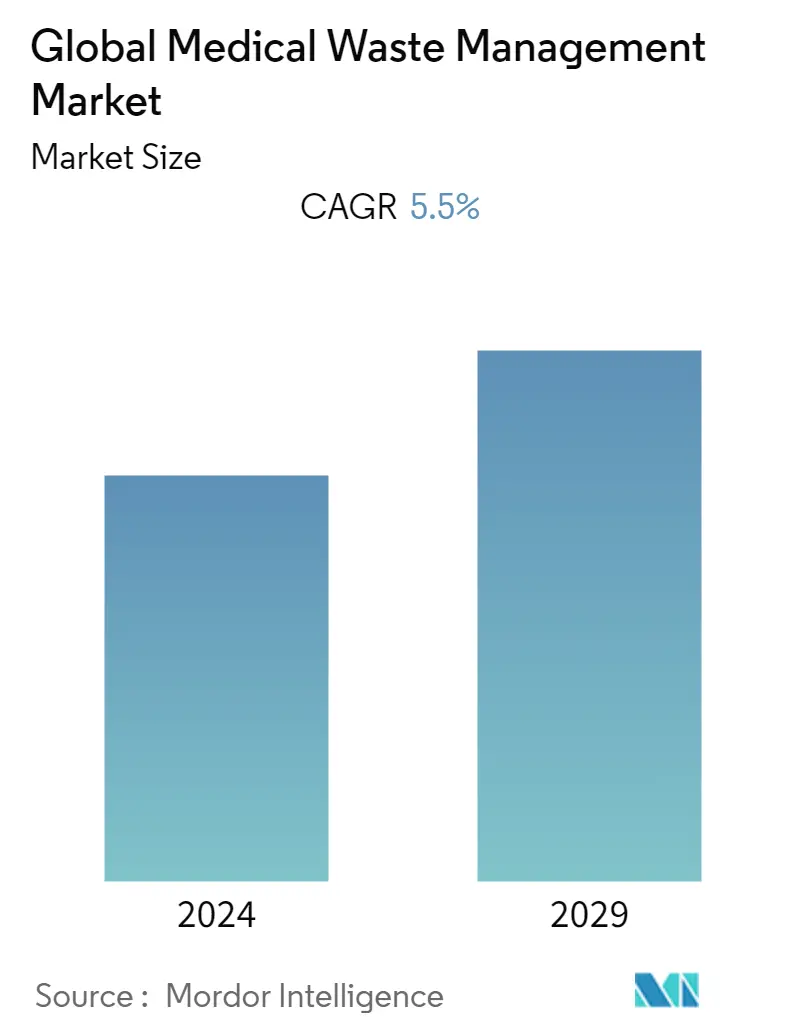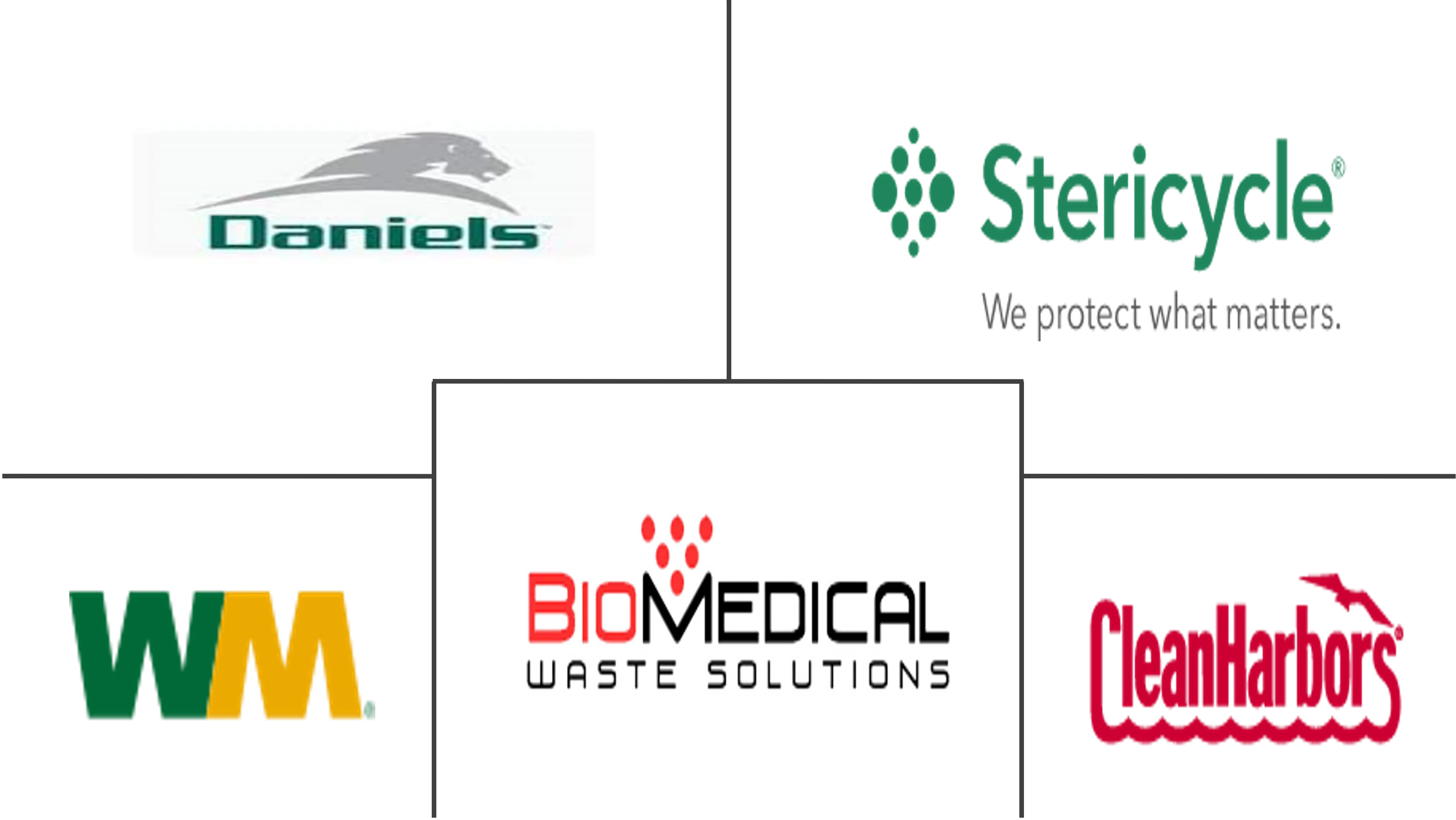Market Size of Global Medical Waste Management Industry

| Study Period | 2019 - 2029 |
| Base Year For Estimation | 2023 |
| Forecast Data Period | 2024 - 2029 |
| CAGR (2024 - 2029) | 5.50 % |
| Fastest Growing Market | Asia Pacific |
| Largest Market | North America |
Major Players
*Disclaimer: Major Players sorted in no particular order |
Medical Waste Management Market Analysis
The Global Medical Waste Management Market is expected to register a CAGR of 5.5% during the forecast period(2024-2029).
Due to the increase in coronavirus-infected populations, the medical waste generated by health facilities has increased tremendously. Special care should be taken when disposing of COVID-19-related medical waste, as it is likely to spread the virus if not incinerated properly. With the growth in medical waste generation amid the outbreak, several authorities worldwide have devised strategies for waste disposal. For instance, in early 2020, the Central Pollution Control Board (CPCB) India provided guidelines for the management, treatment, and disposal of waste generated during the treatment, diagnosis, and confinement of COVID-19 patients. This has had a positive impact on market growth. Additionally, in August 2021, the Chinese government and the United Nations Development Program (UNDP) jointly launched a new initiative in Nepal to help seven hospitals in the South Asian country improve their healthcare waste management systems to better handle the waste generated during the COVID-19 pandemic. Thus, COVID-19 has had a significant impact on the growth of the market.
Population growth worldwide is increasing the number of patients, leading to an increase in the volume of medical waste generated. Thus, with the increase in medical waste, governments around the world are taking new steps to combat the issue. For example, in India, the Ministry of Environment and Forests (MoEF) introduced the Medical Waste Management and Handling Rules, 1998, and the Bio-Medical Waste (Management and Handling) (Amendment) Rules, 2003 to provide official and mandatory guidelines for health care waste management. The Central Pollution Control Board has also issued guidelines on Central Medical Waste Treatment Plans (CBWTF).
Moreover, a growing number of government-sponsored programs are also driving the market for medical waste management. Several government agencies adhere to laws relating to medical waste. These include the Occupational Safety and Health Administration (OSHA), the Centers for Disease Control (CDC), the U.S. Food and Drug Administration (FDA), the Department of Transport (DOT), and the Drug Enforcement Administration (DEA). Additionally, the initiatives taken by the governments of different countries are also propelling the growth of the market. For instance, in August 2021, the Indian government virtually inaugurated a decentralized biomedical waste incinerator at Buxar Municipality, Bihar. The technology developed by Ganesh Engineering Works was selected through the Biomedical Waste Treatment Innovation Challenge launched in June 2020 by the Waste to Wealth Mission.
Furthermore, the advancement in technology is also contributing to the growth of the market. For instance, in February 2022, Envetec Sustainable Technologies Limited launched its GENERATIONS technology. It is a breakthrough cleantech solution that safely treats biohazardous waste and materials, including plastics, glass, PPE, sharp containers, and other general laboratory consumables, on-site at the source. Envetec is one of the pioneers in environmentally friendly, cleantech solutions engineered for laboratories in the diagnostic, pharmaceutical, medical device, and food and beverage industries. With the introduction of GENERATIONS, Envetec became one of the world's first and only cleantech companies with a validated technology providing treatment at the source to eliminate the existing harmful treatment and disposal of biohazardous waste and materials.
Thus, the market is expected to experience growth over time. However, the need to invest heavily due to the demand for high-value equipment and new technological equipment may hinder the growth of the medical waste management market.
Medical Waste Management Industry Segmentation
As per the scope of the report, medical waste contains infectious material, and it is the waste generated by healthcare facilities like physician's offices, hospitals, dental practices, laboratories, medical research facilities, and veterinary clinics. Medical waste can contain bodily fluids like blood or other contaminants. Some examples are culture dishes, glassware, bandages, gloves, discarded sharps like needles or scalpels, swabs, and tissue. The Medical Waste Management Market is segmented by Type of Waste (Non-hazardous Waste and Hazardous Waste), Treatment (Incineration, Autoclaving, Chemical Treatment, and Other Treatments), Service (Collection, Transportation, and Storage, Treatment and Disposal, Recycling, and Other Services), Treatment Site (Offsite Treatment and Onsite Treatment), and Geography (North America, Europe, Asia-Pacific, Middle East and Africa, and South America). The market report also covers the estimated market sizes and trends for 17 countries across major regions globally. The report offers the value (in USD million) for the above segments.
| By Type of Waste | |
| Non-hazardous Waste | |
| Hazardous Waste |
| By Treatment | |
| Incineration | |
| Autoclaving | |
| Chemical Treatment | |
| Other Treatments |
| By Service | |
| Collection, Transportation, and Storage | |
| Treatment and Disposal | |
| Recycling | |
| Other Services |
| By Treatment Site | |
| Offsite Treatment | |
| Onsite Treatment |
| Geography | ||||||||
| ||||||||
| ||||||||
| ||||||||
| ||||||||
|
Global Medical Waste Management Market Size Summary
The medical waste management market is poised for significant growth, driven by the increasing volume of medical waste generated globally due to factors such as population growth and the COVID-19 pandemic. The pandemic has notably accelerated the demand for effective waste management solutions, as the surge in medical waste from healthcare facilities necessitated stringent disposal measures to prevent virus transmission. Governments worldwide have responded by implementing regulations and guidelines to manage this waste, such as India's Medical Waste Management and Handling Rules and initiatives by the Chinese government and UNDP in Nepal. Technological advancements, like Envetec's GENERATIONS technology, are also contributing to market expansion by offering innovative solutions for on-site treatment of biohazardous waste. Despite the promising growth prospects, the market faces challenges, including the need for substantial investment in high-value equipment and new technologies.
Regionally, North America is expected to dominate the medical waste management market, supported by its advanced healthcare sector and the increasing need for diverse waste management treatments due to the high volume of biomedical waste produced. The United States, in particular, is seeing a rise in recycling initiatives within hospitals, further driving market growth. The competitive landscape of the market is characterized by strategic partnerships and collaborations among key players, such as Stericycle and UPS Healthcare, to enhance service offerings and market presence. Additionally, international efforts, like the UNDP's project in Japan and the launch of MediWaste in Bermuda, highlight the global commitment to addressing the challenges of medical waste management. As the market continues to evolve, these factors are expected to propel its growth over the forecast period.
Global Medical Waste Management Market Size - Table of Contents
-
1. MARKET DYNAMICS
-
1.1 Market Overview
-
1.2 Market Drivers
-
1.2.1 Increasing Initiatives by Government Authorities
-
1.2.2 Increasing Awareness of Medical Waste
-
1.2.3 Increasing Medical Waste
-
-
1.3 Market Restraints
-
1.3.1 Technological Advancements
-
1.3.2 High-capital Investments
-
-
1.4 Porter's Five Forces Analysis
-
1.4.1 Threat of New Entrants
-
1.4.2 Bargaining Power of Buyers/Consumers
-
1.4.3 Bargaining Power of Suppliers
-
1.4.4 Threat of Substitute Products
-
1.4.5 Intensity of Competitive Rivalry
-
-
-
2. MARKET SEGMENTATION (Market Size by Value - USD Million)
-
2.1 By Type of Waste
-
2.1.1 Non-hazardous Waste
-
2.1.2 Hazardous Waste
-
-
2.2 By Treatment
-
2.2.1 Incineration
-
2.2.2 Autoclaving
-
2.2.3 Chemical Treatment
-
2.2.4 Other Treatments
-
-
2.3 By Service
-
2.3.1 Collection, Transportation, and Storage
-
2.3.2 Treatment and Disposal
-
2.3.3 Recycling
-
2.3.4 Other Services
-
-
2.4 By Treatment Site
-
2.4.1 Offsite Treatment
-
2.4.2 Onsite Treatment
-
-
2.5 Geography
-
2.5.1 North America
-
2.5.1.1 United States
-
2.5.1.2 Canada
-
2.5.1.3 Mexico
-
-
2.5.2 Europe
-
2.5.2.1 Germany
-
2.5.2.2 United Kingdom
-
2.5.2.3 France
-
2.5.2.4 Italy
-
2.5.2.5 Spain
-
2.5.2.6 Rest of Europe
-
-
2.5.3 Asia-Pacific
-
2.5.3.1 China
-
2.5.3.2 Japan
-
2.5.3.3 India
-
2.5.3.4 Australia
-
2.5.3.5 South Korea
-
2.5.3.6 Rest of Asia-Pacific
-
-
2.5.4 Middle East and Africa
-
2.5.4.1 GCC
-
2.5.4.2 South Africa
-
2.5.4.3 Rest of Middle East and Africa
-
-
2.5.5 South America
-
2.5.5.1 Brazil
-
2.5.5.2 Argentina
-
2.5.5.3 Rest of South America
-
-
-
Global Medical Waste Management Market Size FAQs
What is the current Global Medical Waste Management Market size?
The Global Medical Waste Management Market is projected to register a CAGR of 5.5% during the forecast period (2024-2029)
Who are the key players in Global Medical Waste Management Market?
Biomedical Waste Solutions, LLC, Clean Harbors, Inc., Daniels Sharpsmart Inc., Stericycle, Inc. and Waste Management, Inc. are the major companies operating in the Global Medical Waste Management Market.

